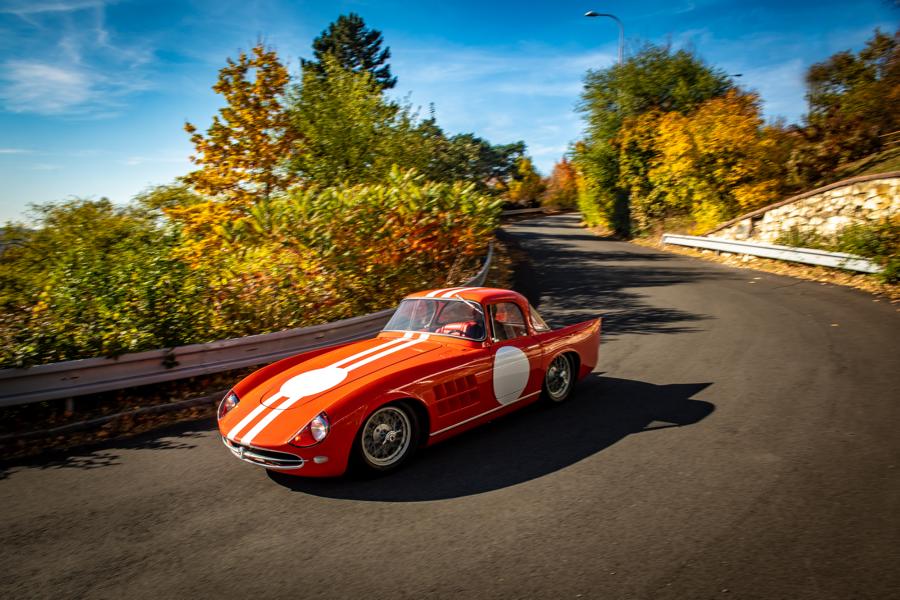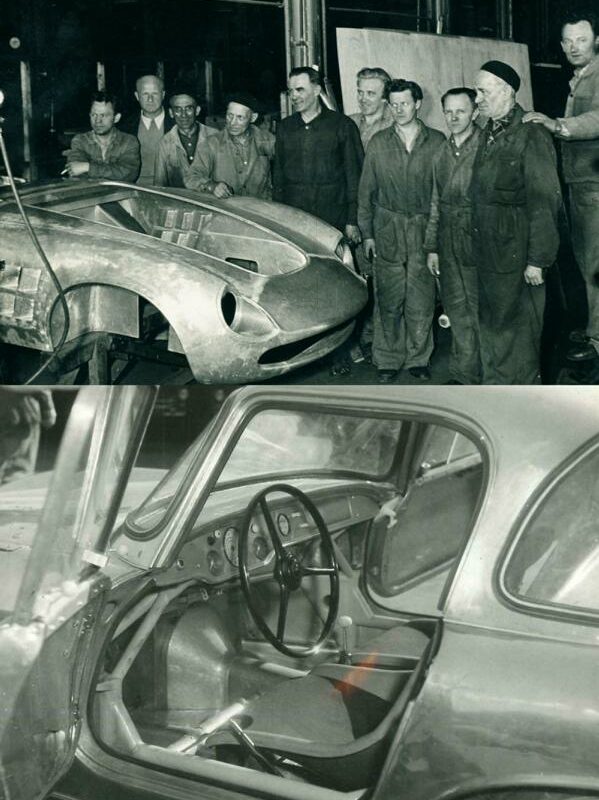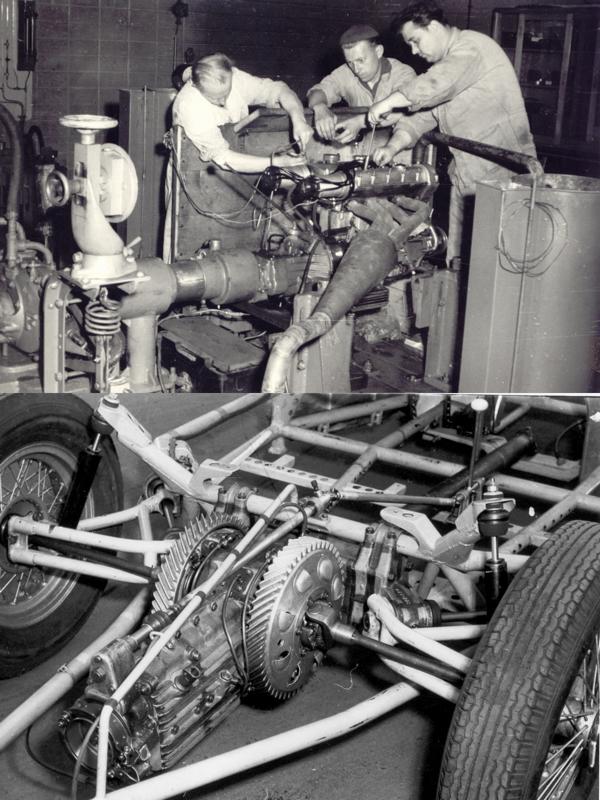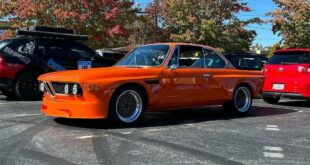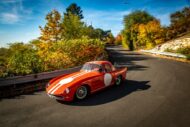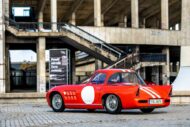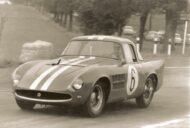To mark the 120th anniversary of ŠKODA Motorsport, employees of the ŠKODA Museum and the Center for Prototyping at ŠKODA AUTO reconstructed the ŠKODA 1100 OHC Coupé racing car. First, the teams worked on remanufacturing the original frame, chassis and engine, and also rebuilt the body according to historical documentation. Modern cutting-edge technologies were used as well as traditional techniques from body construction. Planning for the ŠKODA 1100 OHC with the internal type designation 968, which was primarily intended to take part in endurance circuit races, began as early as spring 1956. At the end of 1957, the first of two examples with an open GRP body was completed. The vehicle is still one of the highlights in the exhibition at the ŠKODA Museum in Mladá Boleslav. It regularly starts at national and international classic car events. The importer ŠKODA UK uses the second 1100 OHC for advertising purposes, especially locally in Great Britain.
Skoda 1100 OHC coupe
In 1959 and 1960, the designers continued to work on the 968 project and developed two ŠKODA 1100 OHC coupés with a closed body. Proven elements of the ŠKODA series models could be adopted. In contrast to the ŠKODA SPORT and SUPERSPORT, which emerged at the end of the 1940s, the basis of the vehicle was no longer the central tube frame with forks for the installation of an OHV engine at the front. Instead, the ŠKODA 1100 OHC Coupé used the advantages of the light and at the same time rigid lattice frame, which was welded from thin-walled tubes. The front wheels were fitted with a trapezoidal suspension, each consisting of two triangular wishbones arranged one above the other, and at the rear a coupled axle with trailing links was used.
The engine was located behind the front axle and, with the assembly unit consisting of rear axle differential and five-speed gearbox, enabled almost ideal weight distribution. The handling of the dynamic racing car was excellent. The ŠKODA 1100 OHC Coupé was powered by an in-line four-cylinder naturally aspirated engine. The cylinder and crankcase were made of aluminum and came from the ŠKODA 440 'Spartak', as did the crankshaft. The racing car surpassed its output of 40 hp (29,4 kW) at 4.200 rpm thanks to optimized combustion chambers and OHC valve drive, a compression ratio of 9,3:1, two carburetors, double dynamo battery ignition from Bosch, ignition magnets from the brand However, Scintilla Vertex and many other modifications clearly. The output was 92 hp (67,7 kW) at 7.700 rpm. The output per liter was a high 85 hp per liter of displacement. The 1100 OHC Coupé briefly reached speeds of up to 8.500 rpm. Depending on the overall gear ratio, which could be adjusted to suit the character of the race track, the two-seater with an aluminum body and an unladen weight of just 555 kilograms reached a top speed of around 200 km/h. Dual-circuit brakes ensured effective deceleration at all times, and the rear drum brakes were located on the differential gear to reduce the unsprung masses.
Racing career from 1960 to 1962
The racing career of the two ŠKODA 1100 OHC Coupé vehicles lasted from 1960 to 1962. Changed technical regulations meant the end of the category under 1.100 ccm. When the vehicles were no longer allowed to start, they were sold to private buyers in 1966. Both coupés were completely destroyed in road accidents. The owner of the first vehicle, whose preserved components were now used in the reconstruction, replaced the engine of his 1100 OHC with a standard four-cylinder with OHV valve control from a FELICIA. The vehicle's original engine was on display at the vocational school in Mladá Boleslav for a long time before it was reconstructed and used again in the 1100 OHC Coupé. The second coupe burned out after an accident. The driver was able to get out of the vehicle, but the aluminum body was irreparably damaged. The technically uniquely designed rear axle with integrated gearbox was removed and first went to the collection of the National Technical Museum in Prague before it was left to the ŠKODA Museum 25 years ago. In 2014, the ŠKODA Museum acquired the tubular space frame, which was disassembled into three parts, with the complete front axle and other preserved parts from a private collector.
rebirth of a legend
The ambitious restoration project would not have been possible without the experts from the ŠKODA Museum and their experience with the open-top ŠKODA 1100 OHC. The original technical documentation was also of great importance. It has been preserved almost completely in the ŠKODA AUTO archive - including an explanation of all production sections and an explanatory drawing for the installation of individual assemblies. The original mechanical components were hardly worn as the car had only taken part in a few races. The renovation of the entire chassis with a reconstructed radiator, fuel tank and other elements was completed at the end of 2015. Originally, the chassis of the car was to be exhibited in the ŠKODA Museum next to the car with an open body. Instead, the decision was made to rebuild the coupé as a fully functional vehicle. The most demanding task was the reconstruction of the aluminum body. The original draft came from the former factory designer Jaroslav Kindl, according to whose documents a wooden model was made at the time. Aluminum plates were first hammered out manually, then the individual parts were welded or riveted.
As part of the reconstruction work, the ŠKODA Museum’s restoration workshop worked closely with colleagues from the ŠKODA AUTO Center for Prototyping. Based on scans of the 2D drawings on a scale of 1:1, a three-dimensional network was created, which was then optically reworked. At great expense, the shapes of individual elements were checked and corrected, for example on the front of the vehicle and in the area of the rear lights. Historical photographs were compared with the drawn documentation and the 3D model. In the virtual studio, the experts were able to view the car from all sides and make corrections. In addition to scaled-down models, 1:1 scale models of the front and rear body components were then created. After appropriate technical assessment, necessary adjustments and final approval, the ŠKODA AUTO designers worked on partitions, wheel arches and other body elements.
For the body, 0,8 and 1 millimeter thick aluminum sheets were used, which were manually processed and welded as part of the reconstruction. Due to the anodized body surface, the two coupés were initially painted blue. However, this surface treatment did not prove successful in racing, so from the middle of the 1962 season both vehicles were given the current red paint finish. For the complex reconstruction, it was necessary to procure numerous components that were identical in construction to the parts from the production vehicles of the time. For example, the coupé's outer door handles corresponded to those of the ŠKODA 1200 'Sedan'. Some switches and the ignition lock were also used in the ŠKODA 440 'Spartak' and the OCTAVIA, and the three-spoke steering wheel covered in black plastic refers to the bestseller from the pre-war period, the ŠKODA POPULAR.
Of course, that wasn't the end of it. Our tuning magazine has tens of thousands of other tuning reports in stock. Do you want to see them all? Just click HERE and look around. Or are you especially interested in our Tuning classics category? Then the following extract of tuned young and old timers is sure to be just the thing to browse.
Skoda 1100 OHC coupe
Photo credit: Škoda
tuningblog.eu - on the subject of cars, motorcycles, bikes / ATV / scooters & Co., and of course our passion, the Tuning, we keep you up to date and report daily on cool vehicles from all over the world. It's best to subscribe to ours Feed and you will be automatically informed as soon as there is a new post.
 tuningblog.eu Your magazine about tuning the car
tuningblog.eu Your magazine about tuning the car
